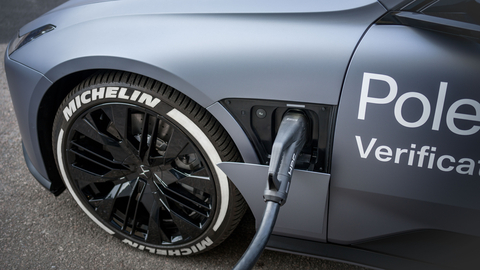Polestar and StoreDot Successfully Charge Polestar 5 Prototype From 10-80% in 10 Minutes

Polestar and StoreDot successfully charge Polestar 5 prototype from 10
This world-first demonstration of a 10 minute 10
This XFC test by Polestar and StoreDot battery engineers was designed to demonstrate proof-of-concept for XFC battery technology that could be applied to future Polestar vehicles.
Thomas Ingenlath, Polestar CEO, says: “Time is one of life’s greatest luxuries, and as a manufacturer of luxury electric performance cars, we need to take the next step to address one of the biggest barriers to EV ownership – charging anxiety. With this new technology, on longer journeys when drivers do stop they’ll be able to spend less time charging and be back on the road faster than before. In fact, that stop time will be more akin to what they experience with a petrol car today.”
StoreDot’s revolutionary XFC technology utilises silicon-dominant cells with an energy density on par with state-of-the-art NMC cells, and does not require specialist cooling systems in the vehicle. The experimental XFC battery’s modules have a structural function which improves mechanical properties and cooling ability while maintaining or reducing weight levels, with high recyclability and serviceability also paramount in the design of the pack.
In today's commercial EV batteries, fast charging rates can vary greatly depending on the battery’s state of charge (SOC), sometimes dropping significantly as SOC increases. During this test, Polestar saw charging speed rise from 310 kW at
Importantly, the test proves XFC technology works with today’s DC charging infrastructure, which continues to feature more high-power DC chargers of 350 kW or higher.
This means drivers will be able to spend less time stopped to charge their vehicle, which for a 10
Dr. Doron Myersdorf, CEO of StoreDot, comments: "We are very excited to share this impressive achievement today and proud to be on this journey with Polestar. Polestar’s commitment acknowledges that extreme fast charging technology is necessary to make widespread electric car adoption a reality. This breakthrough revolutionises ownership by eradicating the barrier of range and charging anxiety once and for all as drivers will be able to travel long distances with the same freedom and convenience as traditional fossil fuel-powered vehicles."
A film showing the testing procedure can be found here: https://www.polestar.com/global/news/how-we-charged-a-polestar-in-10-minutes/
Ends.
About StoreDot
StoreDot is the pioneer and world leader of extreme fast charging (XFC) electric vehicle batteries that overcome the critical barriers to mainstream EV adoption – range and charging anxiety. The company has revolutionized the conventional Li-ion battery by innovating and synthesizing proprietary organic and inorganic compounds, optimized by Artificial Intelligence algorithms, enabling the charging of an EV in under 10 minutes – similar experience to refueling a conventional combustion engine car.
Through its '100inX' product roadmap, StoreDot's battery technology is delivering ‘Range on Demand™’: 100 miles charged in 5 minutes in 2024, 100 miles charged in 4 minutes in 2026, and 100 miles charged in 3 minutes by 2028. StoreDot's strategic investors and partners include BP, Daimler, VinFast, Volvo Cars, Polestar, Ola Electric, Samsung, TDK, and its manufacturing partner EVE Energy.
StoreDot’s media kit can be found at this link.
About Polestar
Polestar (Nasdaq: PSNY) is the Swedish electric performance car brand determined to improve society by using design and technology to accelerate the shift to sustainable mobility. Headquartered in
Polestar plans to have a line-up of five performance EVs by 2026. Polestar 2, the electric performance fastback, launched in 2019. Polestar 3, the SUV for the electric age, launched in late 2022. Polestar 4, the SUV coupé transformed, is launching in phases through 2023 and into 2024. Polestar 5, an electric four-door GT and Polestar 6, an electric roadster, are coming soon.
The Polestar 0 project supports the company’s ambitious goal of creating a truly climate-neutral production car by 2030. The research initiative also aims to create a sense of urgency to act on the climate crisis, by challenging employees, suppliers and the wider automotive industry, to drive towards zero.
Forward-Looking Statements
This press release contains statements that are not historical facts, but rather forward-looking statements within the meaning of Private Securities Litigation Reform Act of 1995. Such forward-looking statements include those that address activities, events or developments that Polestar or its management believes or anticipates may occur in the future. All forward-looking statements are based upon, as applicable, our current expectations, various assumptions and data available from third parties. Our expectations and assumptions are expressed in good faith and we believe there is a reasonable basis for them. However, there can be no assurance that such forward-looking statements will materialize or prove to be correct as forward-looking statements are inherently subject to known and unknown risks, uncertainties and other factors which may cause actual future results, performance or achievements to differ materially from the future results, performance or achievements expressed in or implied by such forward-looking statements. Numerous risks, uncertainties and other factors may cause actual results to differ materially from those set out in the forward-looking statements, including those risks and uncertainties set forth in the sections entitled “Risk Factors” and “Cautionary Note Regarding Forward-Looking Statements” in Polestar’s Form 20-F, and other documents filed, or to be filed, with the
View source version on businesswire.com: https://www.businesswire.com/news/home/20240429036717/en/
Graeme Lambert
graeme.lambert@polestar.com
Head of Design & Innovation PR
Source: Polestar







